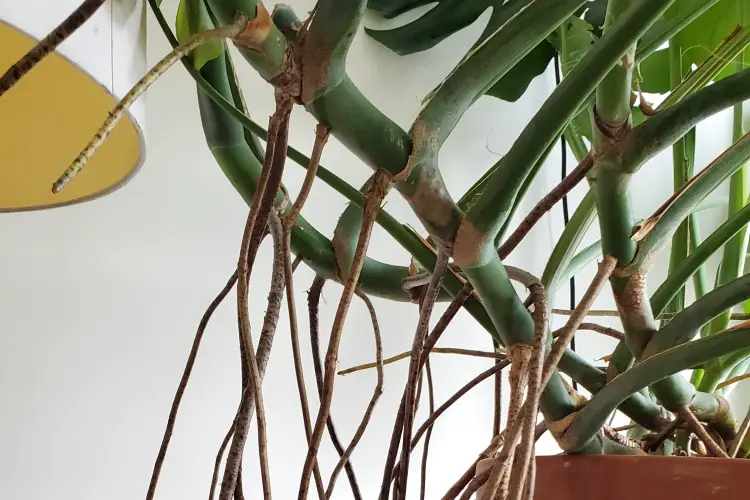
What are aerial roots?
Aerial roots are, as the name says, roots that grow not in the soil, but in air. They grow on plant stems above the soil.
Many plants grow aerial roots – monstera, pothos, philodendrons, rubber trees, ficuses and other plants.
Benefits of aerial roots (What’s their purpose?)
The purpose of aerial roots is the same as regular roots:
- To stabilize a plant, but instead of stabilizing the plant in the soil as soil roots do, aerial roots help anchor a plant to trees or other structures and help it climb. In nature, a lot of vining plants use these roots to climb trees, so they can reach higher points in the canopy with more light. One example would be a monstera plant.
- Another purpose of aerial roots is to help absorb moisture and dissolved nutrients from the rainwater running down the roots and trees
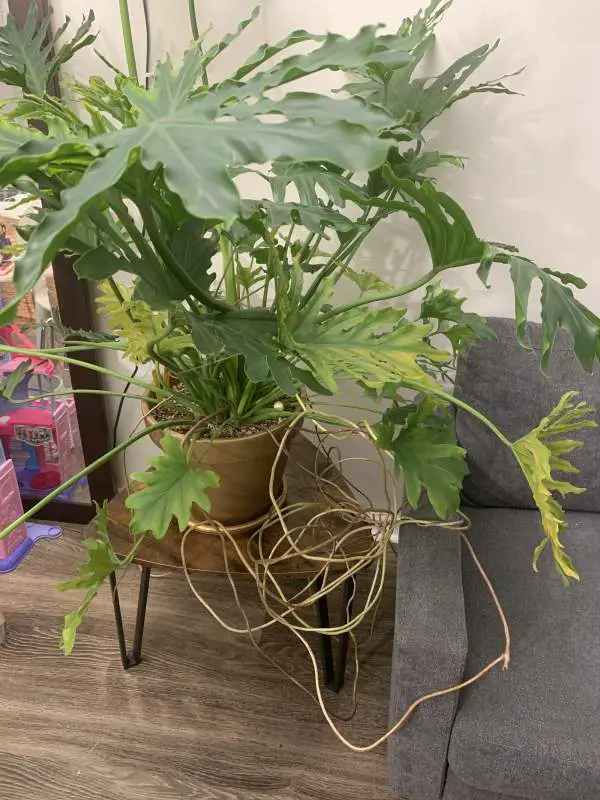
Aerial roots on my Philodendron Selloum (Thaumatophyllum Bipinatifidum)
So aerial roots are great in nature, they must be very helpful indoors as well?
Since there is no rain indoors, aerial roots in our homes do not perform the function of moisture and nutrient absorption. But they are useful if you want your plant to climb up a moss pole or a trellis.
Aerial roots can also be helpful with propagation. When you take a cutting, take one with an aerial root, it will make propagation easier, as most aerial roots are very likely to continue growing in water or soil.
Which plants can have aerial roots?
Many plants can have aerial roots – Monstera Deliciosa, Golden Pothos, many philodendrons, Rubber Tree (Ficus Elastica), Fiddle Leaf Fig (Ficus Lyrata), succulents (Echeveria for example) and many other plants.
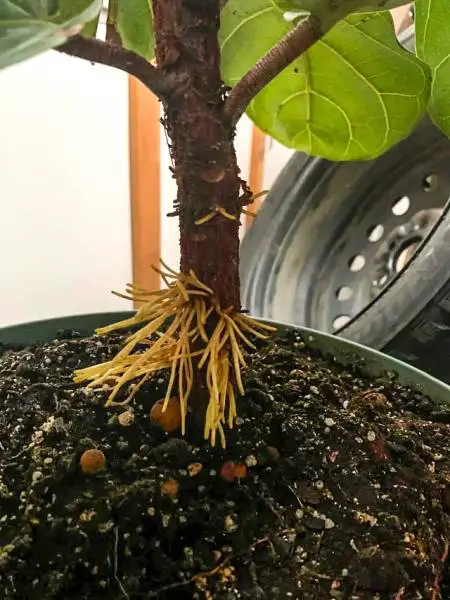
Aerial roots on Ficus Lyrata
Why does my monstera have so many aerial roots?
Aerial roots on monstera plants are not uncommon for this plant, especially if the conditions are right – high humidity, warm and bright. This is because the plant is a climber, and these monstera’s aerial roots help it to attach itself to surfaces and climb upward. The aerial roots can also help the plant to absorb moisture and nutrients from the air when outdoors. Indoors the aerial roots don’t serve much of a purpose, besides climbing.
My plant doesn’t have aerial roots. Is there something wrong with it?
Absolutely not! A pothos might grow aerial roots in one person’s home, but not in another. They are not an indicator of health. If your plant doesn’t have it, that is nothing to worry about.
There are a lot of discussions in the horticultural community on what exactly causes aerial roots to grow in different plant species. One of the factors discussed is humidity. High humidity and greenhouse-like conditions seem to be favorable for the growth of aerial roots.
Top 5 tips for dealing with aerial roots (what can you do with them)
Here are the top 5 tips for dealing with these aerial roots:
- Depending on the plant and the size of the aerial roots, I often like the way aerial roots look like. If you feel the same, you can leave them and let them grow. You can mist them if you like, but you don’t have to do it.
- You can also put them in soil, so they can continue to perform their function – absorb moisture and nutrients
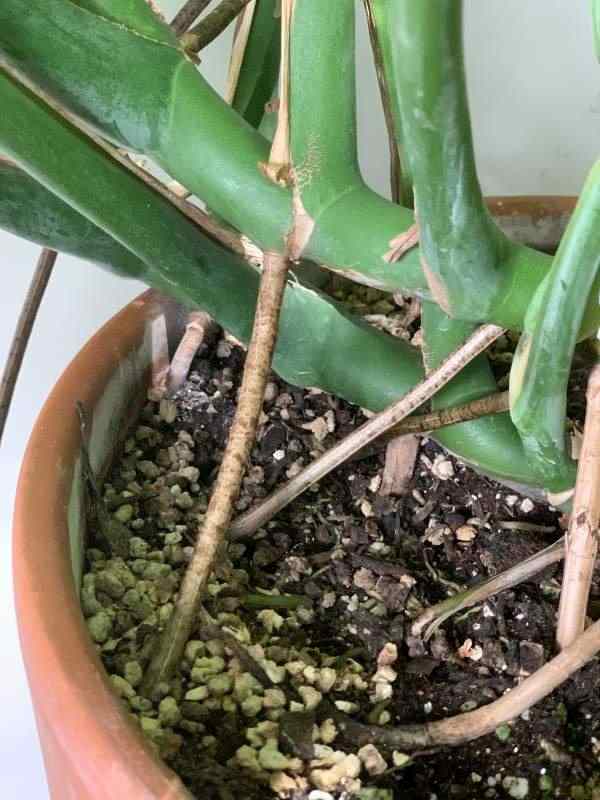
Monstera's aerial roots growing into soil
-
- Some people find aerial roots unsightly. If you’re one of them, feel free to simply cut them off. You will not harm the plant. In the same way that pruning of soil roots will not harm your plant (and actually promotes root branching), pruning of aerial roots will in no way harm your plant. If you want to remove them fully, cut them as close to the main stem as possible. Even though I usually don’t sterilize my pruning shears, doing so is the best practice as it reduces the chances of the wound getting infected. You can use hydrogen peroxide for sterilization or rubbing alcohol. Perhaps you like the way aerial roots look, but they are getting too long. In the case of very long aerial roots, trim them, and reduce their length to what works for you and your space. Again, you will not be harming the plant. Don’t worry, they will continue to grow.
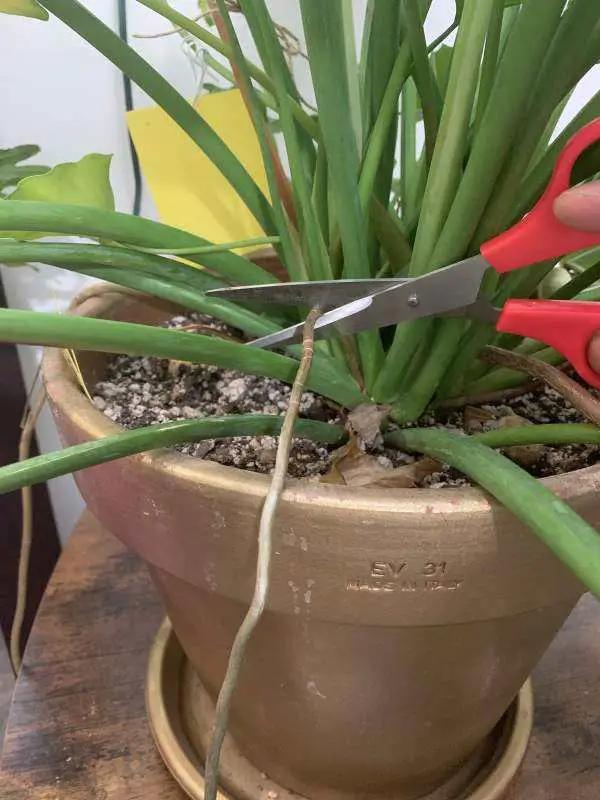
Cutting of aerial roots on Philodendron Selloum (Thaumatophyllum Bipinatifidum)
- There are some exceptions to root trimming, such as orchids. Do not trim orchid roots. Orchids are epiphytes, in nature, they live attached to trees with their aerial roots. All orchid roots in our homes are in fact aerial, regardless of some of them being in bark or sphagnum moss and others being suspended in the air. If you cut an orchid’s aerial roots, you would be removing roots that are essential for the plant to absorb moisture and nutrients. Orchids also often don’t have the density and length of roots that non-epiphytic plants have, and every healthy root will help them with moisture absorption and will assist them to start growing stronger. It’s also believed that orchid roots possess the ability to photosynthesize, which is another reason to leave them.
- Some people put aerial roots in a vase with water or bury them in another pot. While I personally don’t find this practical, as another vase or a pot takes up additional space, you can do it. The roots should absorb water from the new vase or pot. However, you could achieve the same effect by putting the aerial roots in the same pot as the plant.
How do you train aerial roots on monstera?
If you want to train your Monstera’s aerial roots, you’ll need to provide it with a support structure to climb. You can use a trellis, a wire mesh, or even just tie the plant’s stems to something nearby. Once the plant has something to climb, the aerial roots should begin to attach themselves to the support.
Can I propagate an aerial root?
Generally no, you can’t just take an aerial root and put it in water or soil and expect to get a new plant. Roots generally don’t contain the cells needed to produce a new plant on their own. If you would like to propagate a plant with aerial roots, take a cutting with a node and one of the aerial roots. There are some exceptions to the rule, plants that can be propagated from just a section of the roots. One example is figs.
Will aerial roots grow back?
Yes, unless there is a change in the plant’s environment or care routine, aerial roots will usually grow back after some time.
What do you do with air roots when repotting orchids?
When repotting orchids, keep the air roots intact, do not cut them off. Unlike other houseplants, aerial roots are essential for orchids. If you want, you can put them in the potting medium (sphagnum moss, bark), as this will make it easier for them to get moisture. Other plants have soil roots to obtain water and nutrients, but orchids only have aerial roots, so removing them would reduce their ability to absorb moisture and nutrients.
Can I put aerial roots in soil?
Yes, you can put aerial roots in soil. By doing that the aerial roots will continue to grow in soil and will now have a purpose – to absorb water and nutrients. While they are suspended in air, due to lack of rain indoors they aren’t able to absorb moisture (unless you are regularly watering or misting them), so they don’t have much of a purpose.
Can i put aerial roots in water?
If you want to put your aerial roots in water, you can do so, but it’s not necessary. If you put these roots in water, they will continue growing and will start absorbing water from the dish they are in.
I hope you found this post helpful. Leave me a comment if you have any additional questions.
Scroll all the way down and subscribe to my newsletter to be the first to receive my houseplant tips!
Yours Truly,

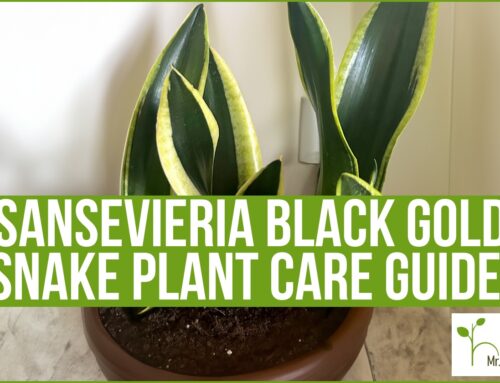
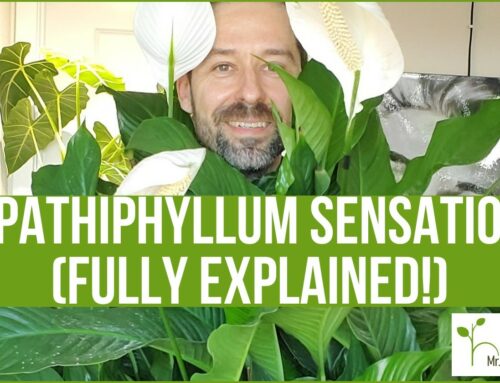
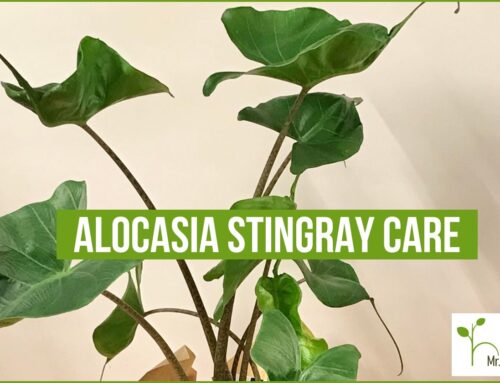

Olá, gostei da explicação sobre raízes.
O que vc fez com elas? Confeccionou algum artesanato, fez alguma cesta ou coisa parecida? Se fez , posta.
I’m sorry, I only speak English and Serbian
From Google translate:
Hi, I liked the explanation about roots.
What did you do with them? Did you make any crafts, make a basket or something similar? If done, post
Hi Maria, that’s a good question. I saved the roots in a bag, it was a huge pile of roots. I was thinking of making something with them, but after a month they became pretty dry and broke easily, so I’m not sure if it would be possible to make anything out of them.
Thanks for the tips
You’re welcome Kathy :)
Thank you very much. I feel less stupid
Hi Stef, I’m really glad you enjoyed the content!
My plant is nearly three years old, five feet high but it has only one point of growth, why so? Please help getting it full growth.
Hi Shiv, which plant do you have? What you need to depend will depend on the species. Generally more light (buy a light meter) and pruning will help plants to get bushier and develop new growth points. You can also prune, propagate and pot the propagated cutting with the original plant :)
Hi! I’m discovering something insane with my mature monstera deliciosa after 5 weeks with the aerial roots in water! My plant is a year old. And had only 2 points of growth the whole time I’ve had it. I saw the roots in water hack on Instagram and decided to try it. I was unimpressed after 4 weeks and took them out of water because nothing seemed to be happening. Until about a week later I noticed some green peeking through the soil, which prompted me to put the roots back in water. That’s been about a 2 weeks ago now and “peeking green” is showing to be a new stem and leaf. Which everything on Google claims is impossible. So tonight I was admiring my plant in amazement and noticed ANOTHER little peeking green out of the soil, in a different spot! My mature monstera is growing new stems and leaves without having ever taking a cutting! Am interpreting this wrong or is my plant some sort of anomaly defying monstera deliciosa odds lol?
Hi Avaiae, thank you for sharing. It’s perfectly normal for monstera plants as well most other vining or climbing plants to occasionally put out completely new growth from the base of the plant. That has happened on my monstera, pothos, and many other plants.
The growth is the result of good care, light, watering, etc. It’s not really related to keeping aerial roots in water.
I’m sorry to say, but you would’ve gotten the new growth regardless of whether your aerial roots were in water or not :)
Keeping the roots in water will provide a little bit of additional water uptake, some minerals from the water, but it will not affect your plant in any significant way. It’s just one out of tens, probably hundreds of roots in the pot. You can simply cut it, keep it in water or put it in soil, but it won’t make a measurable difference in the plant’s health and progress
Hi! I have a Monstera that is ready to propagate, but the node that I want to propagate has a long (20+ inches), straight aerial root coming right out the bottom of it. I have gently tried to bend it to see if I could get it to circle around the inside of a glass jar while I’m growing the roots out, but I’m almost certain it will break.
What do you recommend I do in order to successfully propagate this part of the plant? If I cut the aerial root back so it’s a more manageable length (3-6 inches), will it rot when I stick the clipping (stem, node, aerial root) in water? Would letting the cut end of it dry for a couple hours or days help prevent it from rotting? Or can I put the clipping in water immediately after trimming back the aerial root?
Any advice you have on this unruly aerial root would be greatly appreciated! :)
Hi Naomi, it’s great that the node has an aerial root coming out of it, it will be easier to propagate the cutting. You can cut the root shorter to make it easier to handle. It will still propagate in water. To be on the safe side, sterilize the pruning shears before making the cut, to avoid any potential infection. They don’t happen often but better safe then sorry. Let the cut part of the aerial root dry out for a day or two, and then take a stem cutting of the plant and put it in water.
Hi! Thank you for the reply! I did as you suggested and will let you know how it goes! :)
You’re welcome :) Good luck! Just be aware that all you can do is provide the best conditions for your cutting and nature will take its course. Sometimes the cutting will root, sometimes it won’t. The more experience you gain by doing this more and more, your success rate will improve, but it will still not be 100%, as we can’t control nature :) I think it’s important to have this perspective, so we don’t stress as much.
Can aerial roots of clusia back into the ground strangulate the rootball of the plant and eventually kill it?
Not any more than any of the soil roots can constrict each other. One of the reasons why you should regularly repot your potted plants is to reduce soil compaction and roots constricting each other’s flow of water and nutrients. If you repot your plants once every year or two, and do a full report, they should be fine.
Thanks, Vlad. Easily the best and most rounded advice this person has found regarding aerial roots and their purpose on plants (which both my pothos and my Imperial Evergreen have). Thank you very much.
Thank you so much Nigel, I’m glad you liked the article :)
This article was very insightful. Thanks!
I’m very happy you liked it, thanks!
Help. My split-leaf philodendron was outside all summer (NY) and one branch grew sideways out of the pot and into the ground. It’s about 40 years old with stems about 3″ in diameter.
Can I simply cut the stem between the old plant and the newly-rooted growth to create a second plant?
Hi Marilyn, so if I understood you well, the branch has aerial roots that grew into the ground? That is basically propagation by layering, you can just cut the branch and have a second plant, since it already rooted. Here is a video on layering that might be helpful: https://www.youtube.com/watch?v=RP78NDRN77w
While you are correct about most houseplants not being able to be propagated via root cuttings (aerial or not), there are definitely plants that can.
Take ficuses for example: Many species of ficuses can be propagated via root cuttings (I currently have 4 ficus salicaria root cuttings that have grown foliage). Roots on some plants have appropriate meristems to reproduce shoots given enough time and pre stored energy.
Just google or YouTube root cutting propagations for examples.
Thank you for your comment Jamie. I was mostly thinking of houseplants, but you made a great point, some species can be propagated from roots alone. I should update the blog post to address what you mentioned.
Hi. My rubber plant has a right leaning branch (the pairing left branch didn’t successfully grow) and started growing earial roots (rainy season now in my location). Am thinking of cutting the leaning branch with aerial roots and plant in soil to properly grow straight upward. Will the rubber plant cutting with aerial roots grow successfully?
Having aerial roots does promote chances of succcessful propagation, but like with any other cutting, there’s no guarantees.
Zdravo, kako si ? Thanks for the very clear instructions on dealing with aerial roots.
Save najlepse.
Aleksandar
Zdravo Aleksandre, thanks, I’m glad you enjoyed the article. All the best!
Should’ve said “sve” !
Hello, thanks for this great article. I have a Monstera Albo which I want to cut and make into two plants, the aerial roots have grown into the soil, does that mean they are now ‘normal’ soil roots? And I don’t have to propagate in water etc? Thank you
Hi Katie, thanks! :) If the monstera aerial roots have grown into soil, no need to propagate that part of the plant, it’s already propagated
Thanks for your reply! :-) I cut it and now it’s hanging off the mother plant, I hope I haven’t killed it
Got my answer and more. Thank you.
Great article.
Thanks
You’re welcome Vana :)
What type of plant is the one in the picture between tips two and three, and I think it’s the same plant as in the main photo as well. I have a plant like that that’s huge, and I haven’t been able to find the name.
Hi Katie, that is Thaumatophyllum Bipinatifidum, or what was previously known as Philodendron Selloum :)
Hi sir I regularly watch your video and blogs.. I just want help that how to create Healthy Growth in Money Plants.
Hi, I assume you’re referring to pachira aquatica. As with all plants, the no. 1 factor for successful growth is good light. I suggest getting a light meter to check the levels of natural light in your home. Or buying some good grow lights. You can find many good grow lights in my Grow Light Finder, which is free to use, and features not only high quality grow lights, but also lists how many hours to keep the lights on and how close to the plant. With a good grow light (and proper usage of the light) you can grow any plant successfully, even if you don’t have any natural light :) Potting mix – you want it to be well-draining, always amend it with 30-50% perlite, bark, pumice or another amendment. When it comes to watering, don’t water on a schedule, but check the soil, it should reach a certain level of dryness before you water again. I hope this helps.
Hi! I had a question regarding a variegated monstera cutting. I received the cutting with an aerial root, one leaf, and a node. I placed the cutting in water after allowing it to dry. I saw dark brown-black appearing on the node yesterday which I believe to be small rot of the node. Since then, I have attempted propagation by only placing the aerial root in the water (to prevent further root rot of the node). Will this work, or should I place both the root and node in the water? Also, do I just cut the part of the node that is darkening in color or leave it? I have propagated many monsteras (never variegated) and have been successful, but this one is being tricky. I change the water every 3-5 days.
Hard to say for certain without a photo, but I wouldn’t cut off the brown part of the cutting, it doesn’t always have to be a sign of infection. If the tissue is getting soft and mushy, in that case yes, cut it right away, all the way to the healthy tissue. And use sterile tools. If it’s not soft, leave it, don’t stress the cutting further and provide more opportunities for infection with additional cuts.
What you’re doing might work, it might not. We can’t control nature. All you can do is provide the best conditions that you can, hope for the best and let nature take its course.
A few other things you could do to help the process and increase chances of success: 1) add a heat mat to increase water temperature 2) add an air pump to the water to increase amount of oxygen 3) use a grow light to increase light, if the cutting is not getting bright
I would personally keep the whole cutting in water, as the bottom section of the stem can absorb moisture and nutrients. Good luck!
Hi. Great article. I have a question that I can’t seem to find the answer to. Maybe you can help. How do you adventitious/aerial roots to stick to a surface without having to tie them. Also, do they have to be touching the surface as soon as they bud or can they be older/longer? I’m specifically referring to Epipremnum, Philodendron, Monstera, Rhaphidophora I want to use natural branches instead of moss/coir poles. I’ve had it happen a few times but don’t know what caused it. Once was with a Tillandsia xerographica mounted (stapled lol) outdoors on a log over summer (Z7a) and the other was a neon pothos in a sunroom in summer (the root grew down into a stack of terra-cotta saucers next to it.) Any info would be so helpful. Thanks! :)
That is a great question! I haven’t really tried to get aerial roots to stick to surfaces yet. I moved to a new apartment recently, and the humidity here is much lower than my previous place (20-30% compared to 60-70%), the light is much lower and it’s not as warm, so all of these factors are leading to my monstera and philodendron selloum not growing as nearly many aerial roots as it did in the previous apartment. But once I get some that I can try attaching, I will report what I learn.
Thank you for this info. I was about to clip and start propagating a few of my plants and my pothos has aerial roots. They are probably 8-10 inches long and very woody. I am now going to cut between each node and put them in spag moss once I trim the aerial roots to about a half inch. I was wondering if that reduced the chance of success but now that I know it doesn’t change whether I leave it or trim it, I’m happy.
I’ve never seen aerial roots like this from a pothos being water propagated in a mason jar but it grew about 10 leaves and I wanna grow it outside of the jar and start over. The water roots are like spaghetti noodles it’s impressive lol. I’ll snap a pic before I do this because I’m gonna have to toss the base of the original prop as the node is nowhere near the roots, hence me having to use a mason jar in the first place. It was a huge fenestrsted Golden pothos from the wild that I had shipped to me.
Hi Karin,
If you’re going to propagate pothos cuttings, I would suggest leaving the aerial roots long, not cutting them. You can do either, and it’s possible you might not even see the difference between the cutting with pruned roots and one with a non-pruned root. But I would try to increase chances of success by not cutting and opening an additional spot for a potential infection.
I brought two huge pothos cuttings from Florida and propagated one in soil and one in water. That was almost 2 years ago. They grew up to my ceiling several times, and I’ve already pruned them twice :)
I have an orchid that has bloomed twice. One of the stems seemed to be dried To my horror it was not. That stem started drying up. The other stem dried all the way to the base. After reading another article I attempted to prune the stalks. I successfully trimmed the stalk down to the base. When I trimmed the other stalk to my horror it had many leaves and aerial roots what should I do now
Hi Jerome, if I understood you correctly, you pruned an orchid flower stalk that had leaves and roots growing on it? They will sometimes grow a new plant on a flower stalk, you can just pot the new plant and make sure the roots are in sphagnum moss or bark. Continue caring for it like you would for the mother plant.
Thank you this was very helpful I’d be interested in your thoughts on the do’s and don’t’s of first time experience with certain plants as well.
Hi Chrisecenia, thank you, I’m glad the post was helpful :) I have several detailed houseplant care articles for different plants and I am expanding the list every week. You are more than welcome to look around the blog, I have articles on rubber tree care, string of pearls care, pothos, fiddle leaf fig, marimo moss balls, venus flytraps… I also have additional information on my social media channels, especially Instagram.
Some general pieces of advice I can give is to measure light, get a light meter. Light is plant food. It is the most important and the most limiting factor for growing houseplants successfully. The second important factor is having a porous potting mix – amending store-bought mixes with different amendments, in order to provide oxygen for the roots. I have a repotting article that has some information on the topic. Once you master those, you will be able to take care of 80% of houseplants without any issues.
Very nice text. Thank you!
Thank you! :)
Hey! So I have a split leaf that was given to me for propagation. Well it came with just a aerial root and the stem with three beautiful big leaves. I have it sitting in a big vase of just enough water to cover the aerial root and stem. Well I just noticed that it is mushy. It’s been about 3 weeks now
Cut off the part that’s mushy. Hopefully there is at least a part of the aerial root that is still hard. Make sure to sterilize the cutting tools. It should continue growing from the remaining part.
What do I do if my succulent has aerial roots? My succulent plant has been getting lots of new stems and they’re beginning to get these roots, and my pot is getting a bit too small for it as well. So, I was wondering if I should just leave them or propagate them and move them to another pot.
Hi Bailynn, you can leave the roots if you like the way they look. Or you can cut them off, it won’t harm the plant.
Regarding the new stems, I don’t know how big your pot is, but succulents generally have a small root system, so they don’t need a lot of space. You can pull the plant out of the pot and see if they have more room to grow. If there isn’t much space left, you can repot :)
Hello I am new to growing plants. I have a cutting of a Monestra two big leaves and an aerial root but I’ve had it in a jar for a couple weeks and noticed I had it in the water. I read it shouldn’t be in water so I took it out but due to its location to the end of the cutting it’s very hard to not have it in the water. Will it harm the the root if it is in the water??
Hi Danielle, nothing to worry about, the aerial root should be in water, that is how it will continue to grow roots. Once it grows a few inches of roots, pot the cutting in soil
I have a 2 year Kangaroo Paw Fern that came in a attic hanging basket. This spring I’ve been wanting to repot in a coco lined basket. My problem I can’t get it out of the pot. The aerial roots have completely covered the pot.
If I understand correctly I should be able to remove some of the aerial roots without damaging the plant. Is that right?
Hi Ellen, it would be helpful if I could see the photo, but we’ll have to figure it out without one :)
One option would be to cut or break the pot, if that’s an option. Another one would be to cut the aerial roots, so you can take the plant out. Since the plant is difficult to get out, it probably has a large rootball inside the pot.
There is one tool that I love and is extremely helpful for getting plants out of pots: https://www.mrhouseplant.com/recommends/repotting-rake-2/ You stick the straight part of it between the soil and the pot and push toward the center of the pot. You go around the pot and repeat the process until the plant slides out easily :)
Hello! I have a Monstera that was given to me, and many of the aerial roots right at the bottom of the plant are all in soil. I’m always worried about overwatering so I pulled a couple of the aerial roots out and they have grown many roots themselves. The best thing would be to stick them back in the soil correct? I’m just scared to cut them.
Hi Christine, actually the chances of overwatering are higher if you pull roots out of the soil. The reason is that now there are less roots that can absorb moisture and nutrients from the soil, and as a result the soil will stay moist longer, increasing chances of root rot.
Yes, the best thing would be to stick the roots back into soil.
I understand you’re scared of cutting them, but you should get used to it. If you decide to do it, you won’t be harming the plant. Take a look at a few bonsai repotting videos, after that you might get the courage to do it :) Just sterilize the pruning shears.
Hi. I have a Swiss Cheese plant that was given to me by my mother when my son was born 41 years ago. It’s beautiful. My question is I’ve only repoted it 3 times. The current pot is 18”. I could go bigger but the plant always gets taller and wider. My son now watches it saying it better keep living since it could be an omen to his life. He’s just kidding. But I want to know if it will remain healthy if left in same pot that is probably all roots at this point. I do fertilize every summer while it sits in the shade on my porch and is watered by the rain
Hi Debbie, it’s a good thing you fertilize it occasionally, as it does need new nutrients.
You don’t have to keep repotting into a bigger pot every time, you can use the same pot and just trim some roots. Full repotting and root pruning can stress the plant though, so I would only recommend it if you have a lot of experience with full repotting and root trimming. I do have an article on potting up and full repotting here: https://www.mrhouseplant.com/blog/how-to-repot-a-houseplant-properly/
If not, you could continue with the same practice until the plant starts struggling and repot then.
You can also topdress the plant with new fresh soil. Remove an inch of topsoil and cover it with new soil. This would provide some additional nutrients without disturbing the plant a lot.
Hope this helps!
If I want to propagate a trunk cutting in soil, rather than water, do I cover the trunk in soil up to the new leaf/new leaves?
Hi Debbie, the important thing is to cover the node on the trunk, the section where the new leaf/new leaves come out.
Thank you for the info on the aerial roots! My Monstera plant is big and have 6 big and long aerial roots, now I know what to do with it.
Hi Estrella, you’re very welcome! :)
OMG…so happy :) answered ALL my questions! Thank you!
I’m really happy to hear that Candace :)
Great Article. Thank you for the detailed explanation. I have propagated my monstera into number of plants. The are growing very well I water for last 6 months. I have so many monstera. I would now like to pot them in soil and give it as house gift to my children and also to my family members. Can you please let me know what kind of soil mixture I should be using and where should I buy it from. Also,I do not add any fertilizer to my original plant. What fertilizer or nutrients I should be up giving to my home plant. Thank you so much in advance and eagerly awaiting your reply/expert advice.
Hi Rupel, I have a detailed article on Monstera care, with information on how to prepare a good potting mix: Soil for monstera. Let me know if you still have any questions :)
As for fertilizer, I recommend this one: https://www.mrhouseplant.com/recommends/fertilizer/ but any 3:1:2 fertilizer will be good. Let me know if you have additional questions.
Is it possible to make a beneficial plant supplement/enzyme by cutting up air roots and soaking them in RO water? I’m thinking of something like SLF-100, extracting hormones and enzymes from the air root cuttings…
I just discovered your blog and I am so excited! Thank you for your expertise.
Hi Austin, thank you so much! 🙂 I appreciate it!
Hello. I’ve got about a dozen orchid plants, in individual pots, sitting side by side on my patio. They tend to like the environment and constantly re-bloom. I’ve noticed twice now, in different plants, that the air roots from one orchid will reach over and dig into/implant itself into the soil of another nearby orchid. Why is this happening? Does the plant need extra nutrients or more water? Is it trying to climb into another plant for stabilization? Thanks
Hi Maxine, this is perfectly normal, there is nothing wrong with the plant. Aerial roots will grow towards areas with moisture, so if they are close to another pot, it can happen they start growing into it.
You can guide the roots back into the original pot, or just let them be suspended in the air 🙂
great info on Monstera, I have a 2 year old of 6 feet now and huge aerial roots growing all over my verandah(conservatory) behind radiator etc so good to know i can remove the rogue ones without damage to Mum!
Hi Janey, yes, you definitely can 🙂